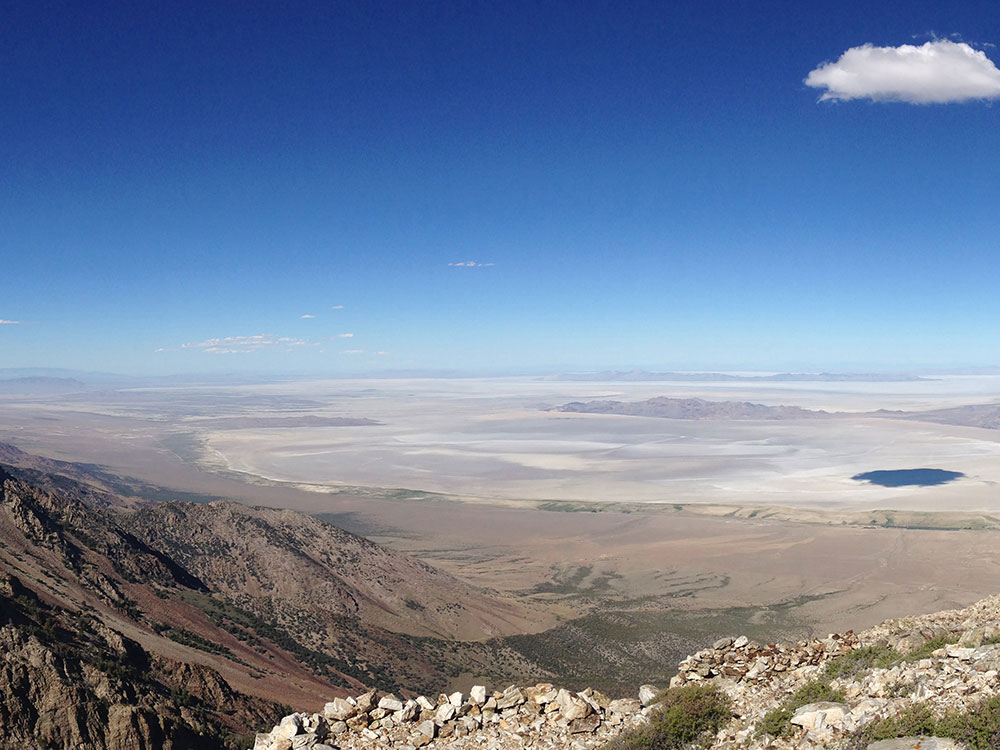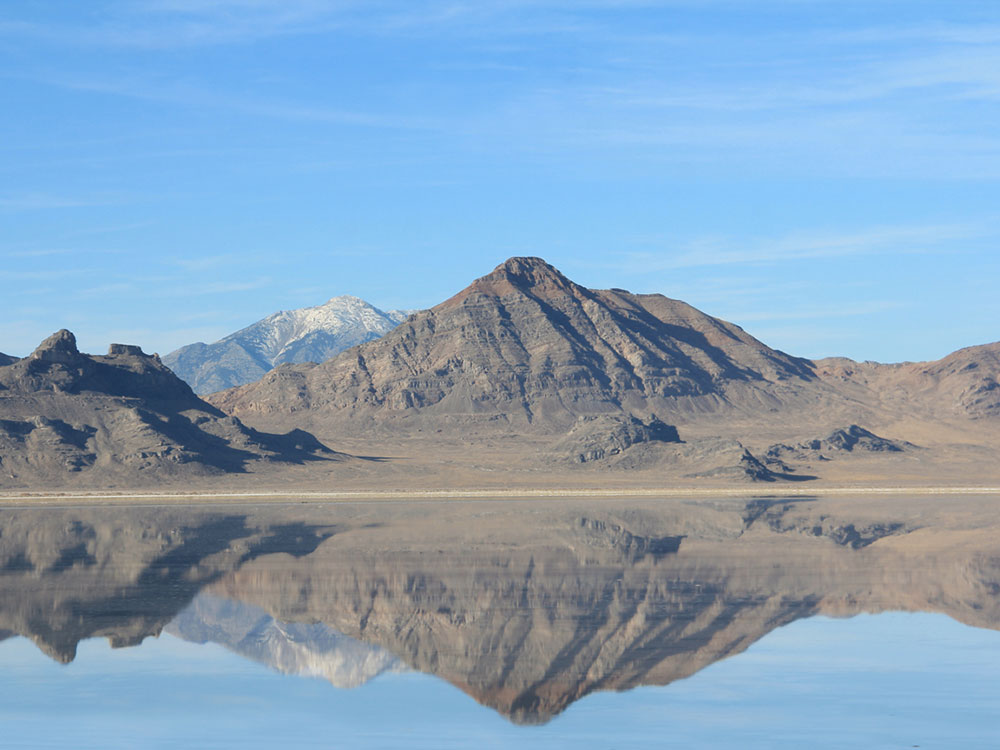30,000 acre expanse of hard, white salt crust on the western edge of the Great Salt Lake basin in Utah
From Salt Lake City (111 miles): Head west on 400 S/University Blvd toward S Main St. Turn left at the 1st cross street onto W Temple. Turn right onto 500 S/Cesar E. Chavez Blvd. Take the I-15 S/I-80 E/I-80 W ramp on the left to S.L. Int'l Airport. Keep right at the fork, follow signs for I-80 W/Reno/S.L. International Airport. Continue onto I-80 W. Take the exit
The Bonneville Salt Flats are a densely packed salt pan in northwestern Utah. The area is a remnant of the Pleistocene Lake Bonneville and is the largest of many salt flats located west of the Great Salt Lake. The property is public land managed by the Bureau of Land Management and is known for land speed records at the "Bonneville Speedway". Access to the flats is open to the public.
The salt flats are about 12 miles long and 5 miles wide with total area coverage of just over 46 square miles. Motor vehicle use is limited by seasonal closure during the spring when the salt is moist or has standing water on the surface. Closure dates may vary and will be posted by sign.
The flats are one of Utah's most iconic landscapes, covering more than 30,000 acres of BLM-managed land in the Salt Lake Field Office. Since 1914, this majestic landscape has served as the racing grounds for generations of land speed racers from around the world. For decades, these passionate racers have tested themselves, each other, and their vehicles in an ever-escalating contest to go faster than ever before.
The potash production canals north of Interstate 80 (I-80), located just east of the Bonneville Salt Flats, are leased and managed by Intrepid Potash and are located on a mix of private property, State of Utah School and Institutional Trust Lands Administration (SITLA) land, and Bureau of Land Management-managed public lands. The canals are industrial facilities leased to Intrepid Potash for potash mining activities and are not designed or safe for public recreation. Therefore, the public should not access, swim, float, kayak, canoe, or pursue any other recreation activities in these industrial canals. In addition, the Utah Highway Patrol has indicated that parking along I-80 to access to the canals is illegal and extremely dangerous due to the proximity to the interstate highway.
Access to the area is via a paved road. Do not venture onto the salt flats if you are unfamiliar with the area as you can break thru the salt crust and become stuck in deep mud if you unknowingly travel too close to the edge of the salt flats.
Geologist Grove Karl Gilbert named the area after Benjamin Bonneville, a U.S. Army officer who explored the Intermountain West in the 1830s. In 1907 Bill Rishel and two local businessmen tested the suitability of the salt for driving on by taking a Pierce-Arrow onto the surface of the flats.
A railway line across the Bonneville Salt Flats was completed in 1910, marking the first permanent crossing. The first land speed record was set there in 1914 by Teddy Tetzlaff.
Entertainment filmed at the salt flats include portions of Knight Rider, Warlock, Independence Day (1996) and its sequel, SLC Punk, Cremaster 2 from Cremaster Cycle, The Brown Bunny, The World's Fastest Indian, Gerry, The Tree of Life, Top Gear, and Pirates of the Caribbean: At World's End. Furthermore, the Pontiac Bonneville (former flagship sedan of the Pontiac motor division), the Triumph Bonneville motorcycle, and the Bonneville International media company are all named for the salt flats.
Motorcar racing has taken place at the salt flats since 1914. Racing takes place at part of the Bonneville Salt Flats known as the Bonneville Speedway. There are five major land speed events that take place at the Bonneville Salt Flats. Bonneville "Speed Week" takes place mid-August followed by "World of Speed" in September and the "World Finals" take place early October.
These three events welcome cars, trucks, and motorcycles. The "Bub Motorcycle Speed Trials" are for motorcycles only. World records are contested at the Mike Cook ShootOut in September. The Southern California Timing Association and the Utah Salt Flats Racing Association organizes and plans the multi-vehicle events, but all event promoters contribute to prepping and maintaining the salt. "Speed Week" events in August were canceled for the second year in a row in 2015, due to poor conditions of the salt in certain parts of the flats. The salt flats had been swamped by heavy rains earlier in the year, which usually happens, but the rains also triggered mudslides from surrounding mountains and onto a section of the flats used for the land-speed racing courses.
Bonneville Speedway (also known as the Bonneville Salt Flats Race Track) is an area of the Bonneville Salt Flats northeast of Wendover, Utah, that is marked out for motor sports. It is particularly noted as the venue for numerous land speed records. The Bonneville Salt Flats Race Track is listed on the National Register of Historic Places.
The salt flats were first used for motor sports in 1912, but did not become truly popular until the 1930s when Ab Jenkins and Sir Malcolm Campbell competed to set land speed records.
In August, the Southern California Timing Association and Bonneville Nationals Inc. organize Speed Week, the largest meet of the year, which attracts several hundred drivers who compete to set highest speed in a range of categories. Bonneville Speed Week has been taking place since 1949.
In late August, the Bonneville Motorcycle Speed Trials are held.
In September each year is the World of Speed, (similar to Speed Week) organized by the Utah Salt Flats Racing Association. The USFRA also meet on the first Wednesday of each month throughout the summer.
In October, the Southern California Timing Association puts on World Finals, a scaled-down version of Speed Week. This event tends to have cooler weather and often drier salt that Speed Week the prior month. There are less spectators and it tends to draw serious racers, as this event is the last chance to break a land speed record and be in the SCTA record book for that year.
Each year, there are usually a few private meets that are not publicized scattered among the larger public meets.
This article uses material from the Wikipedia article "Bonneville Salt Flats", and "Bonneville Speedway", which is released under the Creative Commons Attribution-Share-Alike License 3.0
This article uses material from the blm.gov website "Bonneville Salt Flats"

-1000.jpg)
-1000.jpg)
-1000.jpg)
